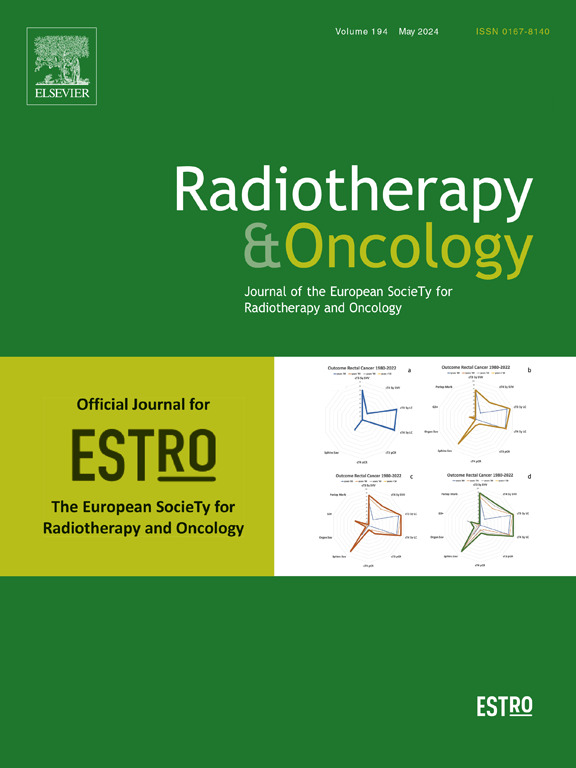基于PSMA-PET和mri的局灶剂量升级放疗治疗中、高危前列腺癌的安全性和生活质量:双中心II期低局灶试验的主要终点分析(ARO2020-01)
IF 4.9
1区 医学
Q1 ONCOLOGY
引用次数: 0
摘要
背景与目的介绍低焦点II期临床试验的主要终点结果、毒性和2年随访后的生活质量(QoL)。材料和方法中高风险前列腺癌(PCa)患者接受中等低分割放疗(MHRT)治疗,60 Gy分为20个部分,a组最高75 Gy的局部强化,或高剂量率近距离放疗(HDR-BT), 15 Gy至全腺体,最高19 Gy的强化。然后进行44 Gy的外束放射治疗(EBRT),分20个部分进行。Boost是基于多参数磁共振断层扫描(mpMRI)和针对前列腺特异性膜抗原(PSMA-PET)的正电子发射断层扫描(PSMA-PET)的综合信息。根据CTCAEv5.0评估泌尿生殖系统(GU)和胃肠道(GI)毒性。使用IPSS、QLQ-PR25和QLQ-PR30问卷评估生活质量。结果MHRT治疗25例,HDR-BT + EBRT治疗30例。2年fu时,2 +级GU和GI毒性发生率在A组分别为24%和8%,在B组分别为10%和0%。在A组中报告了两例3级胃肠道毒性,可归因于多因素发生和干预。生活质量良好,仅在A组的肠道症状和b组的性功能方面存在显著和极微小的差异。局限性在于样本量相对较小。结论:这是第一个证明基于mpMRI和PSMA-PET的MHRT和HDR-BT + EBRT的局灶剂量递增在中高危险PCa中的安全性和可行性的试验。特别是,HDR-BT具有良好的毒性和生活质量。放射性直肠炎需要仔细治疗。本文章由计算机程序翻译,如有差异,请以英文原文为准。
Safety and quality of life of PSMA-PET- and MRI-based focal dose escalated radiotherapy for intermediate- and high-risk prostate cancer: Primary endpoint analysis of the bi-centric phase II HypoFocal trial (ARO2020-01)
Background and Purpose
To present the primary endpoint results, toxicities and quality of life (QoL) after two-year follow-up (FU) of the HypoFocal Phase II trial.
Material and Methods
Intermediate- and high-risk prostate cancer (PCa) patients were treated with moderately hypofractionated radiotherapy (MHRT) of 60 Gy in 20 fractions and a focal-boost of up to 75 Gy in Arm A, or high-dose-rate-brachytherapy (HDR-BT) of 15 Gy to the whole-gland with a boost of up to 19 Gy, followed by external beam RT (EBRT) of 44 Gy in 20 fractions in Arm B. Boost was based on combined information by multiparametric-magentic-resonance-tomography (mpMRI) and positron-emission-tomography targeting prostate-specific-membrane-antigen (PSMA-PET). Genitourinary (GU) and gastrointestinal (GI) toxicities were assessed according to CTCAEv5.0. QoL was assessed with validated questionnaires (IPSS, QLQ-PR25 and QLQ-PR30).
Results
Twenty-five patients were treated with MHRT and 30 patients with HDR-BT + EBRT. At two-year-FU, the rate of grade 2 + GU and GI toxicity was 24 % and 8 % in Arm A and 10 % and 0 % in Arm B, respectively. Two grade 3 GI toxicities were reported in Arm A, which can be attributed to multifactorial genesis and interventions. QoL was good with significant and minimally-important-differences only in bowel symptoms in Arm A and sexual functioning in Arm B. One patient in each arm relapsed. Limitations are the relatively small sample size.
Conclusion
This is the first trial do demonstrate safety and feasibility of focal dose-escalation based on mpMRI and PSMA-PET in MHRT and HDR-BT + EBRT in intermediate- and high-risk PCa. Particularly, HDR-BT offers good toxicity and QoL profiles. Radiation proctitis demands careful management.
求助全文
通过发布文献求助,成功后即可免费获取论文全文。
去求助
来源期刊

Radiotherapy and Oncology
医学-核医学
CiteScore
10.30
自引率
10.50%
发文量
2445
审稿时长
45 days
期刊介绍:
Radiotherapy and Oncology publishes papers describing original research as well as review articles. It covers areas of interest relating to radiation oncology. This includes: clinical radiotherapy, combined modality treatment, translational studies, epidemiological outcomes, imaging, dosimetry, and radiation therapy planning, experimental work in radiobiology, chemobiology, hyperthermia and tumour biology, as well as data science in radiation oncology and physics aspects relevant to oncology.Papers on more general aspects of interest to the radiation oncologist including chemotherapy, surgery and immunology are also published.
 求助内容:
求助内容: 应助结果提醒方式:
应助结果提醒方式:


